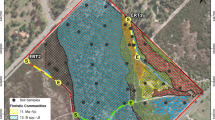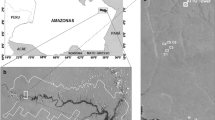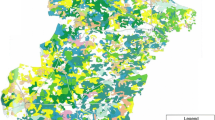Abstract
Floodplain forests are generally areas of high plant diversity compared with upland forests. Higher environmental heterogeneity, especially variation in belowground properties may help explain this high diversity. However, there is little information available on the spatial scale and pattern of belowground resources in floodplain forests. Geostatistics and coefficient of variation (CV) were used to describe the spatial variability of 20 soil properties ranging from essential plant nutrients, such as NH4 or PO4, to nonessential elements like Ti or V. The spatial variation of Si-to-(Al + Fe) ratio, an index of soil development, was also analyzed. Semivariograms and maps of selected properties were used to discriminate between the effect of flooding (and other mechanisms that may contribute to large scale trends in data) and local heterogeneity. The hypothesis that elements mainly cycled through biological processes (such as N) show different spatial properties than elements cycled through both biological and geological processes (such as P) or elements under strict geological control (such as Ti or V) is also presented. Redox potential was the most variable property (CV = 1.35) followed by mineral N, phosphate, organic matter, and carbon. Nonessential elements for organisms such as Si, Al, Ti, Rh, or V were less variable, supporting the hypothesis that biological control on soil properties leads to higher spatial variability. The range (the average distance within which the samples correlate spatially) varied between 3.89 m for water content to 18.5 m for the Si-to-(Al + Fe) ratio. The proportion of the total variance that can be modeled as spatial dependence (structural variance) was very variable, ranging between 0.34 for Fe and 0.96 for K. The addition of the large trend had a strong influence on the CV of most soil variables and created a gradient in C accumulation and the mineral weathering rate. The results suggest that flooding and other processes that are responsible for large spatial trends in the floodplain forest differentially affect biologically and geologically controlled variables with different turnover rates, thus providing a heterogeneous edaphic environment.








Similar content being viewed by others
References
Allen SE, Grimshaw HM, Rowland AP. 1986. Chemical analysis. 2nd ed. In: Moore PD, Chapman SB, editors. Methods in Plant Ecology. Oxford: Blackwell Scientific Publications
JA Amador AM Glucksman JB Lyons JH Gorres (1997) ArticleTitleSpatial distribution of soil phosphatase activity within a riparian forest. Soil Sci 162 808–25 Occurrence Handle1:CAS:528:DyaK2sXnslOku7w%3D
VE Buhrke R Jenkins DK Smith (1997) A practical guide for the preparation of specimens for X-ray fluorescence and X-ray diffraction analysis. Wiley-VCH New York
AK Darke MR Walbridge (2000) ArticleTitleAl and Fe biogeochemistry in a floodplain forest: Implications for P retention. Biogeochemistry 51 1–32 Occurrence Handle10.1023/A:1006302600347 Occurrence Handle1:CAS:528:DC%2BD3cXmtVCisLs%3D
AK Darke MR Walbridge BG Lockaby (1997) ArticleTitleChanges in Al and Fe crystallinity and P sorption capacity in a floodplain forest soil subjected to artificially manipulated flooding regimes in field mesocosms. Wetlands Ecol Manage 4 235–44
CH Ettema DC Coleman G Vellidis R Lowrance S Rathbun (1998) ArticleTitleSpatiotemporal distributions of bacterivorous nematodes and soil resources in a restored riparian wetland. Ecology 79 2721–34
CH Ettema DA Wardle (2002) ArticleTitleSpatial soil ecology. Trends Ecol Evol 17 177–83
RA Farley AH Fitter (1999) ArticleTitleTemporal and spatial variation in soil resources in a deciduous woodland. J Ecol 87 688–96
SP Faulkner WH Patrick Jr RP Gambrell (1989) ArticleTitleField techniques for measuring wetland soil parameters. Soil Sci Soc Am J 56 883–90
A Gallardo JJ Rodriguez–Saucedo F Covelo R Fernandez–Ales (2000) ArticleTitleSoil nitrogen heterogeneity in a Dehesa ecosystem. Plant Soil 222 71–82 Occurrence Handle10.1023/A:1004725927358 Occurrence Handle1:CAS:528:DC%2BD3cXmtleitrk%3D
KL Gross KS Pregitzer AJ Burton (1995) ArticleTitleSpatial variation in nitrogen availability in three successional plant communities. J Ecol 83 357–67
IGME. 1981. Mapa geológico de España. Hoja n° 261: Tuy. Servicio de Publicaciones. Ministerio de Industria y Energia. Madrid
EH Isaaks RM Srivastava (1989) An Introduction to Applied Geostatistics. Oxford University Press New York
RB Jackson MM Caldwell (1993a) ArticleTitleThe scale of nutrient heterogeneity around individual plants and its quantification with geostatistics. Ecology 74 612–4
RB Jackson MM Caldwell (1993b) ArticleTitleGeostatistical patterns of soil heterogeneity around individual perennial plants. J Ecol 81 683–92
F Jeltsch SJ Milton WRJ Dean N Van Rooyen KA Moloney (1998) ArticleTitleModelling the impact of small-scale heterogeneities on tree–grass coexistence in semi-arid savannas. J Ecol 86 780–93 Occurrence Handle10.1046/j.1365-2745.1998.8650780.x
LK Kirkman RR Sharitz (1993) ArticleTitleVegetation disturbance and maintenance of species diversity in intermittently flooded Carolina bays in South Carolina. Ecol App 4 177–188
MJ Lechowicz G Bell (1991) ArticleTitleThe ecology and genetics of fitness in forest plants. II. Microspatial heterogeneity of the edaphic environment. J Ecol 79 687–96
P Legendre M-J Fortin (1989) ArticleTitleSpatial pattern and ecological analysis. Vegetatio 80 107–38
HW Markewich MJ Pavich (1991) ArticleTitleSoil chronosequence studies in temperate to subtropical, low-latitude, look-relief terrain with data from the eastern United States. Geoderma 51 213–39 Occurrence Handle10.1016/0016-7061(91)90072-2
JP Megonigal WH Patrick Jr SP Faulkner (1993) ArticleTitleWetland hydrology, redox potential, and soil O2 content in relation to hydric soil morphology and wetland delineation. Soil Sci Soc Am J 57 140–9
MW Palmer (1990) ArticleTitleSpatial scale and patterns of species–environment relationships in hardwood forest of the north Carolina piedmont. Coenoses 5 79–87
WH Patrick Jr RP Gambrell SP Faulkner (1996) Redox Measurements of Soils. Methods of Soil analysis. Part 3. Chemical Methods. SSSA Book Series No. 5. Soil Science Society of America and American Society of Agronomy Madison, WS
GP Robertson (1987) ArticleTitleGeostatistics in ecology: interpolating with known variance. Ecology 68 744–8
GP Robertson MA Huston FC Evans JM Tiedje (1988) ArticleTitleSpatial variability in a successional plant community: patterns of nitrogen availability. Ecology 69 1517–24
GP Robertson JR Crum BG Ellis (1993) ArticleTitleThe spatial variability of soil resources following long-term disturbance. Oecologia 96 451–6
GP Robertson KL Gross (1994) Assessing the heterogeneity of belowground resources: quantifying pattern and scale. MM Caldwell RW Pearcy (Eds) Exploitation of environmental heterogeneity by plants. Academic Press San Diego, CA
GP Robertson KM Klingensmith MJ Klug EA Paul JR Crum BG Ellis (1997) ArticleTitleSoil resources, microbial activity, and primary production across an agricultural ecosystem. Ecol Appl 7 158–70 Occurrence Handle1:CAS:528:DyaK2MXis1Kntbo%3D Occurrence Handle7999996
RE Rossi DJ Mulla AG Journel EH Franz (1992) ArticleTitleGeostatistical tools for modelling and interpreting ecological spatial dependence. Ecol Monogr 62 277–314
WH Schlesinger (1997) Biogeochemistry. An Analysis of Global Change. 2nd ed. Academic Press San Diego, CA
WH Schlesinger JF Reynolds GL Cunningham LF Huenneke WM Jarrell RA Virginia WG Whitford (1990) ArticleTitleBiological feedbacks in global desertification. Science 247 1043–8 Occurrence Handle1:CAS:528:DyaK2sXltVSgsr4%3D Occurrence Handle9228032
WH Schlesinger JA Raikes AE Hartley AF Cross (1996) ArticleTitleOn the spatial pattern of soil nutrients in desert ecosystems. Ecology 77 364–74
RR Sharitz WJ Mitsch (1993) Southern floodplain forests. WH Martin SG Boyce AC Echternacht (Eds) Biodiversity of the Southeastern United States. Wiley New York 311–72
Silva–Pando FJ, Garcia Martinez XR, Valdes–Bermejo E. 1988. Vegetación de las Gándaras de Budiño. Diputación Provincial de Pontevedra
GK Sims TR Ellsworth RL Mulvaney (1995) ArticleTitleMicroscale determination of inorganic nitrogen in water and soil extracts. Commun Soil Sci Plant Anal 26 303–16 Occurrence Handle1:CAS:528:DyaK2MXjsFOgt7s%3D
D Tilman (1988) Plant strategies and the dynamics and structure of plant communities. Princeton University Press Princeton, NJ
BB Trangmar RS Yost G Uehara (1985) ArticleTitleApplication of geostatistics to spatial studies of soil properties. Adv Agron 38 45–9
PM Vitousek RW Howarth (1991) ArticleTitleNitrogen limitation on land and in the sea—how can it occur? Biogeochemistry 13 87–115
Acknowledgements
My sincere thanks go to Rocio Cameselle, Maria Rey, Sonia Escudero, and Jorge Millos, technicians of the University of Vigo, who did most of the chemical analysis. A group of enthusiastic students helped me with the field measurements and sampling. This work was financed by the Spanish Ministerio de Educación y Tecnologia (Grant PB96-0349) and the Galician government (Grant PGIDTOOMAM5020PR).
Author information
Authors and Affiliations
Corresponding author
Rights and permissions
About this article
Cite this article
Gallardo, A. Spatial Variability of Soil Properties in a Floodplain Forest in Northwest Spain . Ecosystems 6, 564–576 (2003). https://doi.org/10.1007/s10021-003-0198-9
Received:
Accepted:
Published:
Issue Date:
DOI: https://doi.org/10.1007/s10021-003-0198-9




